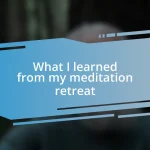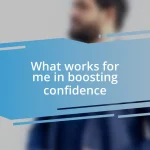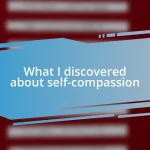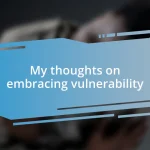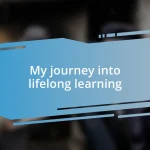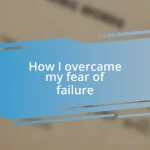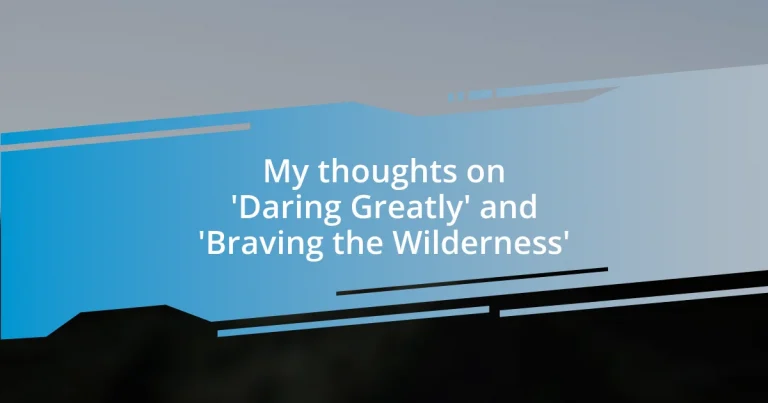Key takeaways:
- Daring to be vulnerable fosters deeper connections and encourages authentic relationships, challenging societal norms around perfectionism.
- Creating a culture of belonging and trust enhances collaboration and innovation, allowing individuals to share their true selves without fear.
- Engaging in open conversations and sharing personal struggles significantly strengthens community bonds and promotes collective courage and growth.
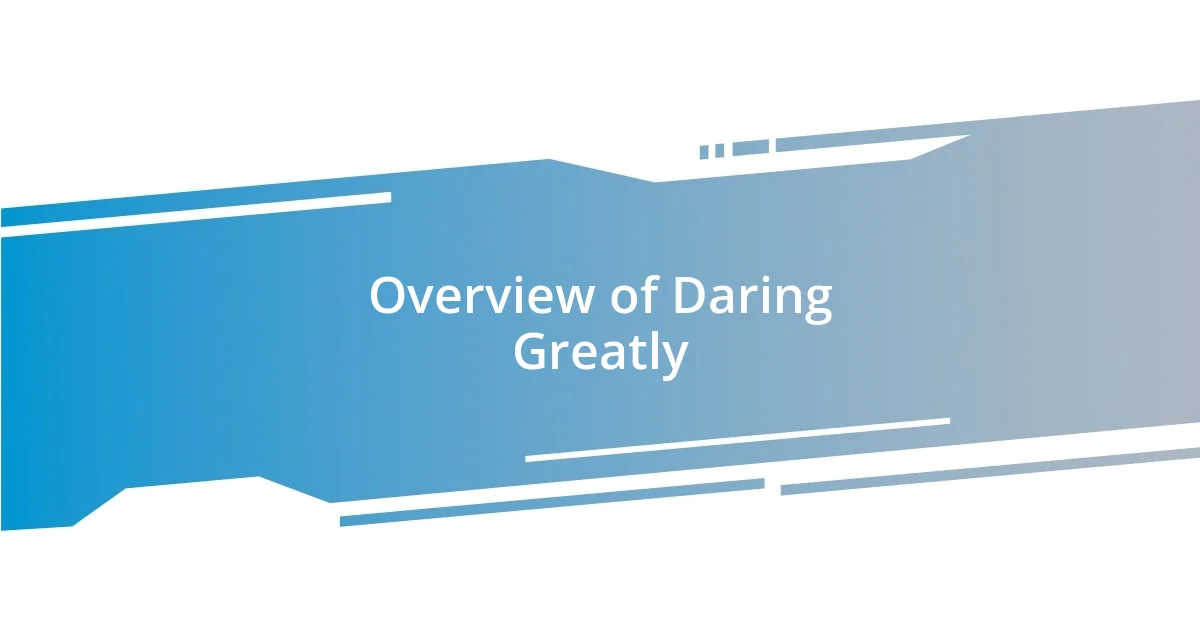
Overview of Daring Greatly
Daring Greatly, by Brené Brown, is a transformative exploration of vulnerability and courage. I remember the first time I connected with her message; it struck me that being vulnerable didn’t mean weakness but rather a bold choice to show up authentically in a world that often rewards perfectionism. Have you ever felt the fear of judgment holding you back? Brown’s work reminds us that embracing vulnerability is the first step toward a richer, more fulfilling life.
The book delves into the idea that vulnerability is a brave act rather than a shameful one. It challenges societal norms that equate success with emotional stoicism, urging us to rethink how we approach our personal and professional lives. When I finally allowed myself to be open and honest in my relationships, I found deeper connections that I never thought possible. Isn’t it fascinating how showing our true selves can lead to an unexpected sense of belonging?
In Daring Greatly, Brown emphasizes the importance of trusting ourselves and others as a foundation for courage. She shares insights from her extensive research, highlighting that the willingness to be vulnerable can ultimately lead to greater innovation and creativity. I often reflect on moments in my life when risk-taking, like pitching a wild idea at work or sharing a personal story, opened up new doors. These instances serve as powerful reminders of the profound impact that daring greatly can have on our lives.
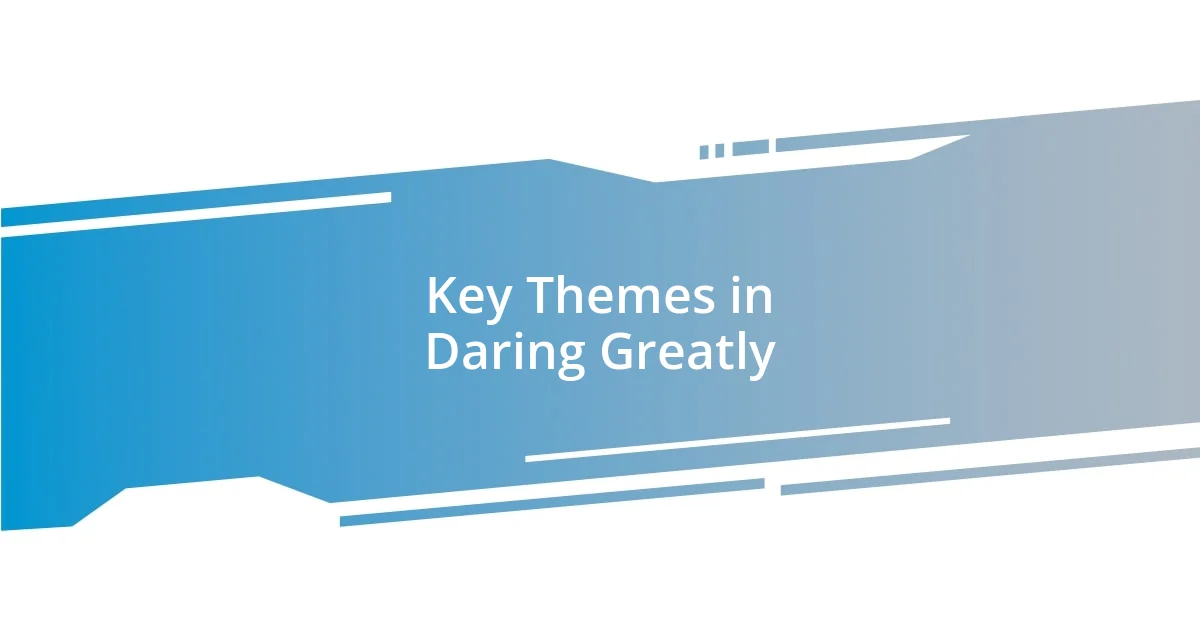
Key Themes in Daring Greatly
One key theme in Daring Greatly revolves around the idea that vulnerability is essential for true connection. I recall a moment during a team workshop where I shared my fear of failure—my hands trembled as I spoke. To my surprise, a colleague opened up about his own struggles, and this honesty rooted us in a shared experience. It was as if a veil lifted; suddenly, we weren’t just coworkers, but human beings navigating the uncertainties of life together.
- Vulnerability as strength: Embracing our imperfections fosters deeper connections.
- The courage to engage: Sharing our stories can transform relationships.
- Redefining success: Moving beyond perfectionism allows for authentic living.
Another theme that resonates with me is the idea of cultivating a culture of belonging. Brown stresses that creating environments where individuals feel safe to share their true selves can ignite trust and collaboration. I’ve seen this in action during team brainstorming sessions; the more open we are about our ideas, the more innovative and effective our solutions become. It’s magic! It reminds us that when we dare to show up, we allow others to do the same.
- The power of belonging: A supportive environment enhances creativity.
- Trust-building: Honesty breeds respect and collaboration.
- Collective courage: Facing fears together leads to shared growth.
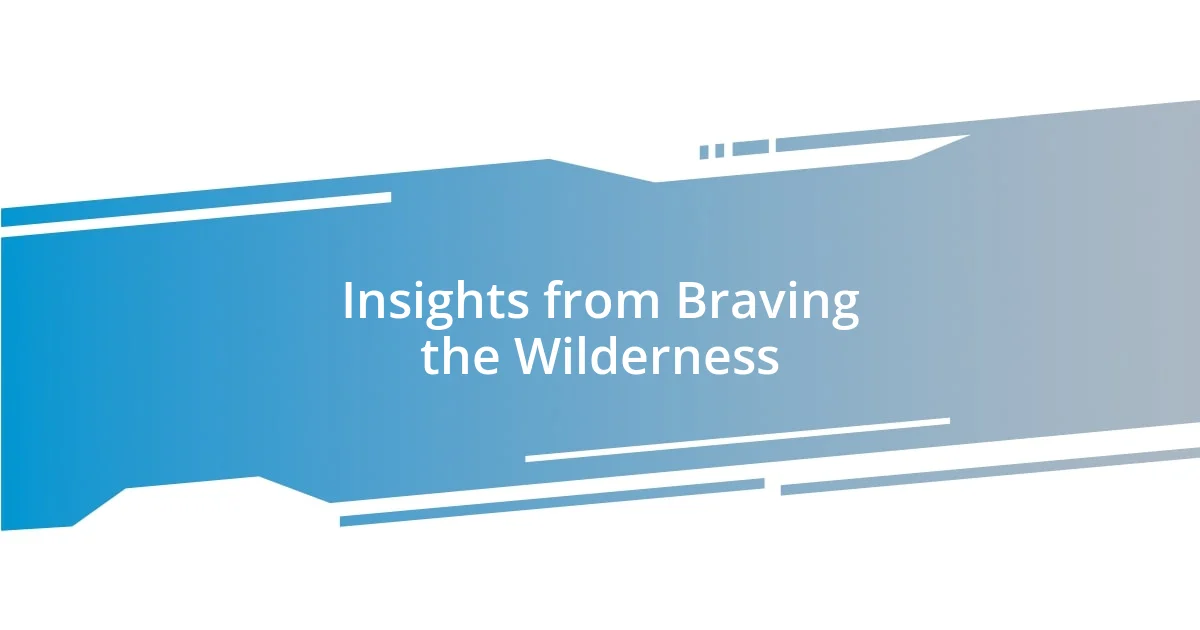
Insights from Braving the Wilderness
Braving the Wilderness presents profound insights into the necessity of belonging and authenticity in our lives. I recall a time when I attempted to fit in with a group by suppressing my true self. It felt exhausting and isolating. However, when I started embracing my quirks instead, I found a community of like-minded souls who appreciated me for who I really was. Could there be a greater relief than shedding the weight of pretense?
Brown beautifully articulates that true belonging doesn’t require us to change ourselves to fit in. Instead, it encourages us to be fully present and authentic, which naturally attracts others. I’ve experienced this firsthand; during a gathering, when I let down my guard, others soon followed. What began as a small exchange turned into an open dialogue of stories and experiences that drew us closer, creating an almost magnetic bond.
When we think about courage in the context of Braving the Wilderness, it’s indeed about showing up as our genuine selves. I’ve found that every time I boldly express my thoughts and feelings, it inspires those around me to do the same. This positive ripple effect fosters a richer community. Can you recall a moment when you chose vulnerability over conformity? Those moments often lead to the most meaningful connections.
| Insights from Braving the Wilderness | Personal Experience |
|---|---|
| Embracing Authenticity | When I stopped pretending, a real community formed around me. |
| Building True Belonging | I witnessed how honesty cultivated deeper connections during casual conversations with friends. |
| Power of Vulnerability | Sharing my fears opened up a dialogue, leading to unexpected support from peers. |
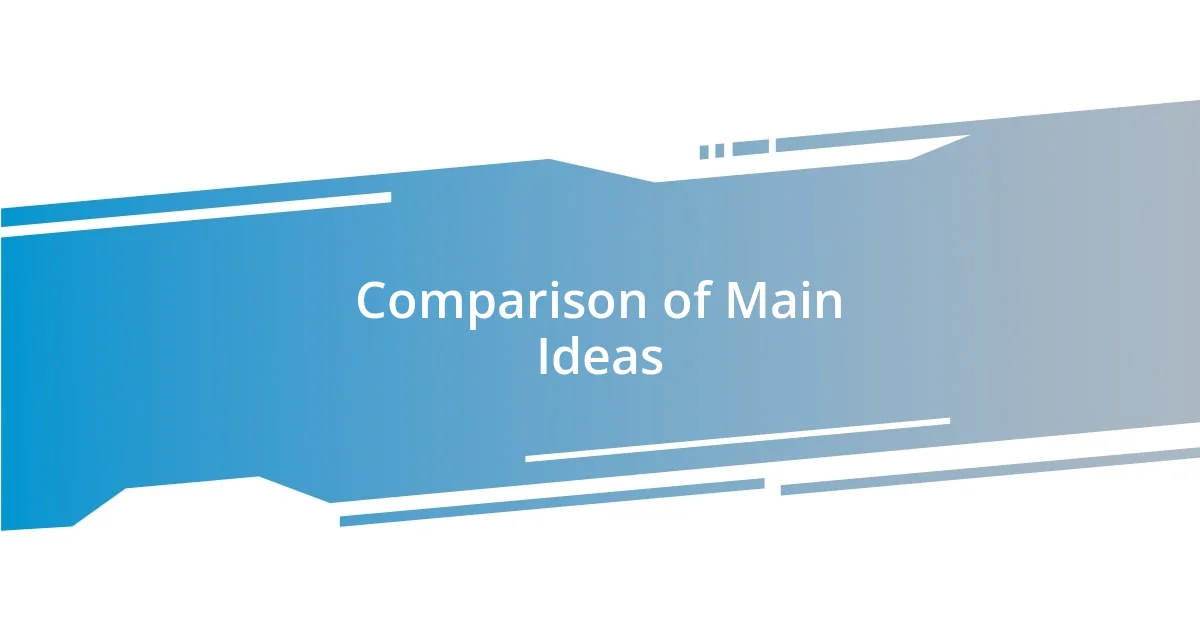
Comparison of Main Ideas
When comparing the main ideas of Daring Greatly and Braving the Wilderness, I can’t help but notice the shared undercurrents of vulnerability and authenticity. In my own life, I’ve often found that embracing vulnerability has paved the way for genuine connections, just as Brown suggests. Reflecting on those moments—like when I willingly shared a deeply personal story at a community event—I realized that while opening up felt intimidating, it remarkably transformed the atmosphere. People responded with their stories, and suddenly, we were all in a safe space together.
Another intriguing comparison lies in the concept of belonging. Both works emphasize that true belonging is not about fitting in but rather being oneself. I remember attending a networking event where I consciously decided to abandon my usual façade. Immediately, I felt a shift; instead of trying to impress others with curated achievements, I simply engaged in heartfelt conversations. The connections I formed that day were far more substantial than any small talk I’d had in the past. It leads me to wonder: How often do we miss out on authentic connections because we choose to wear masks instead of showing our true selves?
Finally, the idea of collective courage resonates deeply across both texts. I often reflect on my experiences collaborating in team projects, where acknowledging individual fears fostered a spirit of shared courage. I recall one instance during a challenging deadline when a teammate voiced their worry about failure. That openness prompted each of us to share our apprehensions. What ensued was not only a surge of support but also a remarkable surge in creativity, as we pooled our strengths to tackle the task ahead. This exemplifies how, when we dare to be vulnerable together, we create a powerful space for collective growth and success.
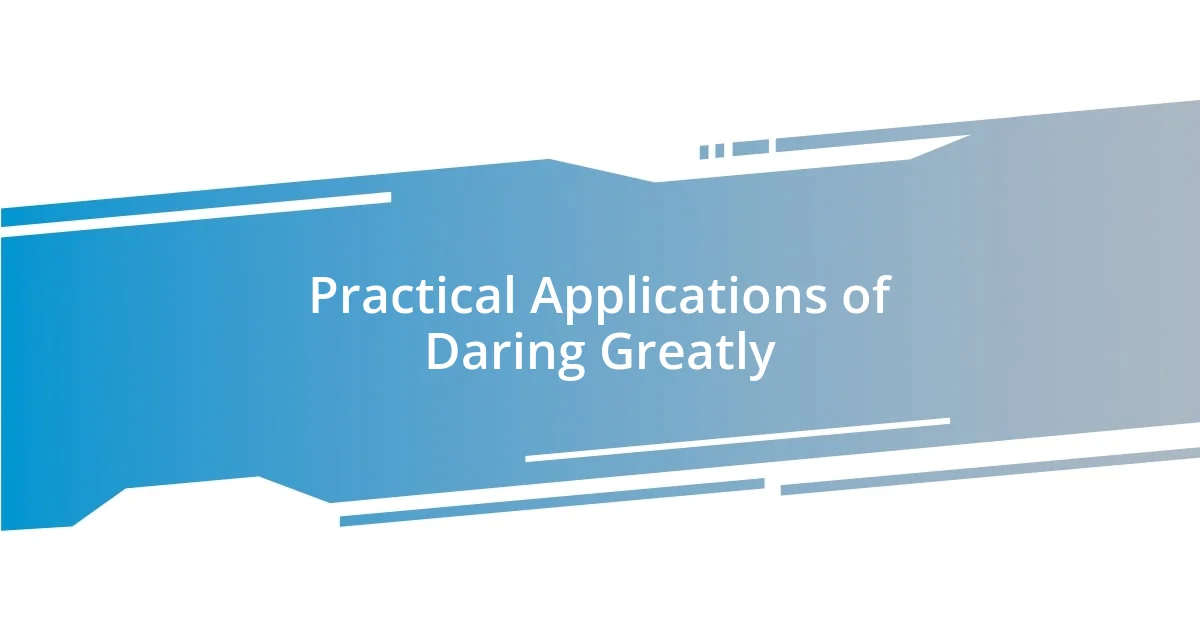
Practical Applications of Daring Greatly
One practical application of Daring Greatly that I’ve embraced is the power of initiating tough conversations. I remember a time when I had a disagreement with a colleague. Instead of brushing it under the rug, I chose to address it directly. It felt daunting initially, but by being honest about my feelings, we were able to clear the air, strengthening our professional relationship in the process. Isn’t it fascinating how facing discomfort can lead to deeper understanding?
Additionally, I often encourage a culture of feedback within my teams. I’ve found that, by inviting constructive criticism, it transforms the dynamic. One project I led was initially met with lukewarm responses. Instead of pushing back, I asked for feedback openly, creating a dialogue that ultimately refined our approach. This experience taught me that asking for help is, in fact, a brave act and can foster a sense of collective ownership among team members. How often do we miss growth opportunities because we fear the feedback?
Lastly, I’ve applied vulnerability by sharing my failures in informal settings. During a casual lunch with peers, I talked about a significant setback I faced early in my career. The response was unexpected; several colleagues revealed their struggles as well. This shift in conversation from success stories to genuine discussions about setbacks not only humanized us but also strengthened our connections. Have you ever noticed how sharing struggles can open the door to deeper camaraderie?
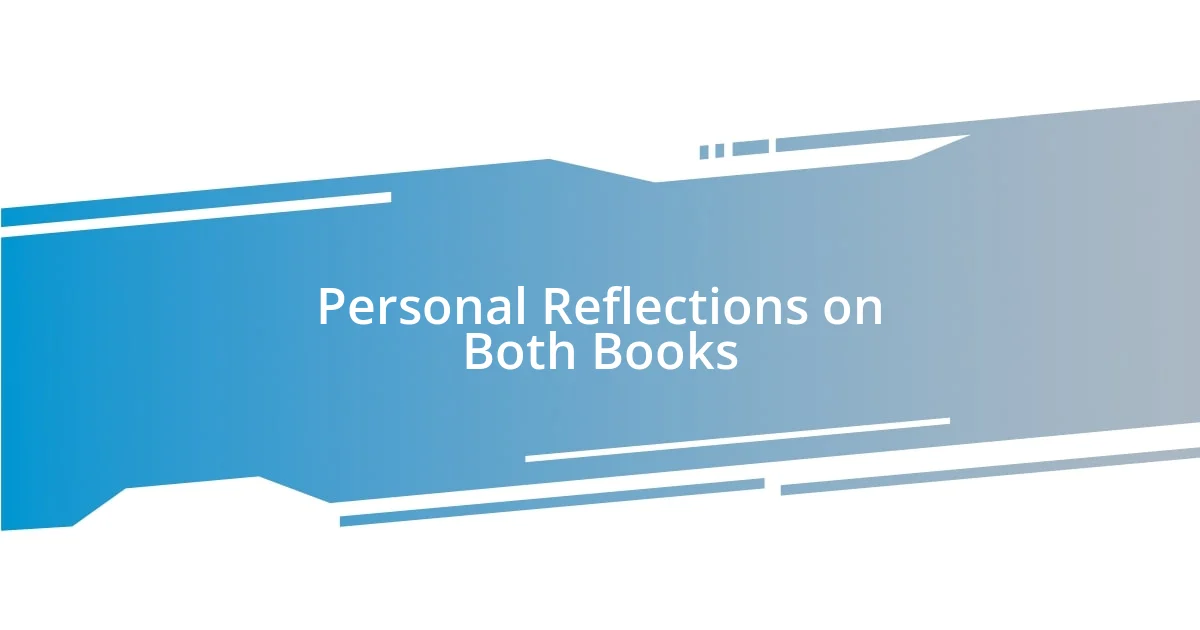
Personal Reflections on Both Books
Reflecting on Daring Greatly and Braving the Wilderness, I can’t help but feel privileged to have traversed my own landscapes of vulnerability as prompted by Brown’s work. There was a moment during a retreat where I was encouraged to share my fears in front of a group. It felt like standing on a diving board, teetering over the unknown, but when I finally leaped, the warmth of acceptance wrapped around me. That experience taught me that exposing our fears often invites others to do the same—this mutual act of courage builds an unbreakable bond.
As for belonging, I remember a family gathering where tensions simmered just beneath the surface. Instead of shying away, I chose to voice my observations about the elephant in the room. The resonance of shared experiences and emotions cascaded around the table, transforming an uncomfortable dinner into an open dialogue. Reflecting on that night, I realized that true belonging is birthed from authenticity, revealing that our stories often interweave in unexpected ways. How often do we shy away from speaking our truth?
Moreover, the concept of collective courage truly resonates with me. I once participated in a community service project where we were tasked with revitalizing a rundown playground. Initially, I found myself hesitating to propose ideas, fearing they might be dismissed. But when a fellow volunteer openly shared her hopes and fears about the project, I felt inspired to join the conversation. This vulnerability led to a flurry of brainstorming, igniting a sense of shared purpose that transformed our group dynamic. It left me pondering: What could we achieve if we dared to bring our full selves into every collaboration?
